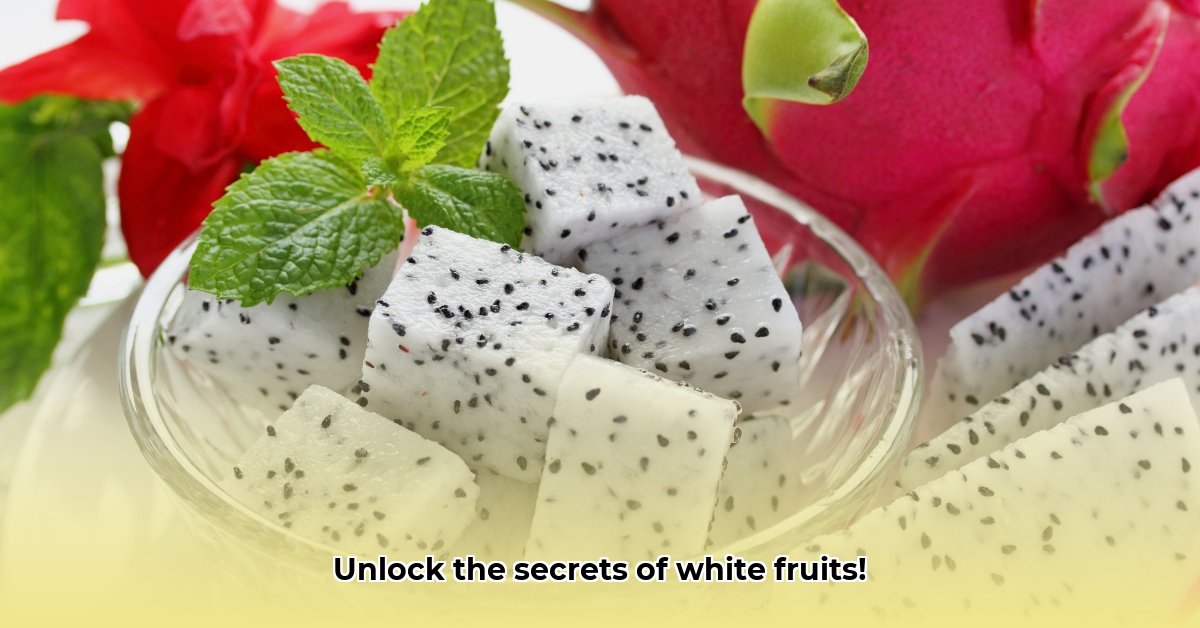White fruits, often overshadowed by their vibrant counterparts, offer a unique and delightful culinary experience. From the familiar banana to the exotic cherimoya, these fruits boast a surprising range of flavors, textures, and nutritional benefits. This comprehensive guide explores the diverse world of white fruits, highlighting their nutritional value, culinary versatility, and the importance of increasing their availability.
Nutritional Powerhouse: Unveiling the Health Benefits
Beyond their delicate appearance, white fruits are packed with essential vitamins, minerals, and fiber that contribute significantly to a healthy diet.
- Potassium Power: Bananas, a readily available white fruit, are renowned for their high potassium content, vital for maintaining healthy blood pressure and muscle function.
- Vitamin C Boost: White guava, a tropical delight, provides a substantial dose of vitamin C, a powerful antioxidant that supports immune function and skin health.
- Fiber Rich: Apples, pears, and coconuts offer dietary fiber, promoting digestive health and aiding in weight management.
- Unique Antioxidants: While not as visually striking as their colorful counterparts, white fruits contain specific antioxidants that contribute to overall well-being.
A Culinary Adventure: Exploring the Variety and Uses
The world of white fruits extends far beyond the everyday apple or banana. Prepare to embark on a culinary adventure as we explore the diversity of these unique fruits:
- Pineberry: A white strawberry with a hint of pineapple, the pineberry adds a unique flavor and visual appeal to desserts and fruit salads.
- Cherimoya: With its creamy, custard-like texture and sweet flavor profile, the cherimoya is a unique tropical fruit perfect for enjoying on its own or incorporating into smoothies.
- White Nectarine: Sweeter than its yellow counterpart, the white nectarine provides a burst of juicy sweetness ideal for snacking or adding to pastries.
- Durian (some varieties): While the pungent aroma may be divisive, the creamy, white flesh of certain durian varieties offers a complex and unique flavor experience.
- Rambutan: The juicy, translucent white flesh of the rambutan delivers a refreshing and sweet flavor, while its spiky red exterior adds an exotic touch.
- Lychee: With its delicate, floral aroma and sweet, slightly tart flavor, the lychee is a versatile fruit enjoyed fresh, added to desserts, or incorporated into Asian cuisine.
- Mangosteen: Often referred to as the “queen of fruits,” the mangosteen’s sweet, tangy white segments offer a unique flavor and a wealth of antioxidants.
- White Sapote: A creamy, custard-like fruit reminiscent of banana and vanilla, the white sapote offers a unique texture and subtle sweetness.
From Selection to Savoring: Maximizing Flavor and Freshness
Proper selection and storage are key to enjoying white fruits at their peak flavor and freshness:
- Selection: Choose fruits that are firm, free of bruises or blemishes, and emit a pleasant aroma. For example, a ripe white peach should yield slightly to gentle pressure.
- Storage: Most white fruits benefit from refrigeration, extending their shelf life and preserving their flavor. However, some fruits, like peaches and nectarines, are best ripened at room temperature before being chilled.
- Preparation: White fruits are incredibly versatile in the kitchen. Enjoy them fresh, blend them into smoothies, incorporate them into baked goods, or experiment with savory dishes. Their subtle sweetness complements a wide range of flavors.
Cultivating Availability: A Collaborative Effort
While some white fruits are readily available, others remain elusive, often found only at specialty markets or farmers’ markets. Increasing their accessibility in mainstream grocery stores requires a collaborative effort:
- Producers: Investing in advanced cultivation techniques, efficient harvesting and transportation methods, and the development of new varieties can enhance the quality, appeal, and shelf life of white fruits.
- Retailers: Educating consumers about the unique qualities of white fruits through attractive displays, informative signage, and recipe suggestions can increase awareness and demand. Partnering with local farmers and offering a diverse selection can further enhance their appeal.
- Consumers: Actively seeking out and purchasing white fruits signals market demand and encourages retailers to expand their offerings. Supporting local farmers’ markets and requesting wider availability at grocery stores can positively influence purchasing decisions.
By working together, producers, retailers, and consumers can elevate the status of these often-overlooked fruits, making them a more accessible and appreciated part of our diets. The increased availability of white fruits not only diversifies our culinary experiences but also enriches our nutritional intake.
- Red Cloud, NE: Discover Willa Cather’s Legacy - April 11, 2025
- Remember Old Social Media Sites? Their Rise and Fall - April 11, 2025
- How many days till Feb 3?Accurate Countdowns & Tools - April 11, 2025
















